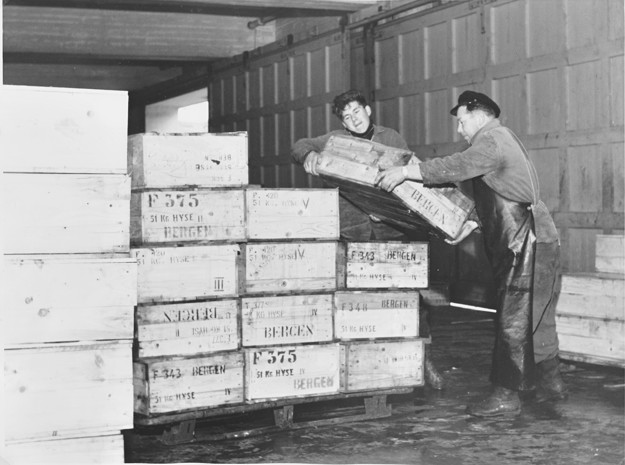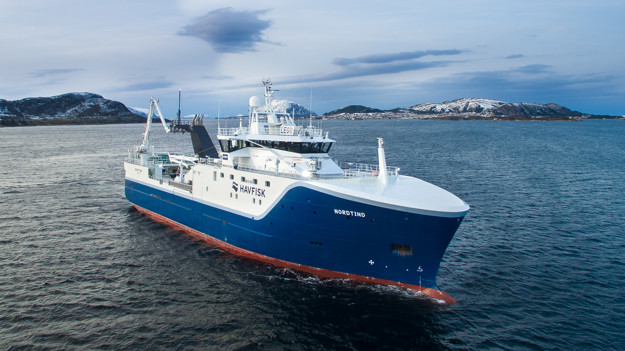Lerøy Seafood Group can trace its origins back to the end of the 19th century, when the fisherman-farmer Ole Mikkel Lerøen (1879-1966) sold live fish at the fish market in Bergen. Ole Mikkel Lerøen would fill corfs with fresh fish, tie them fast to the aft of his boat and row them to market, a journey that could take between six and twelve hours, depending on prevailing winds and currents. Over time, the fisherman-farmer’s operations gradually came to include retail sales in Bergen, the sale of live shellfish and a budding export business.
In 1939, two of his employees, Hallvard Lerøy sr. and Elias Fjeldstad, established a wholesaler and seafood export company – Hallvard Lerøy AS. After some time, the company invested in premises where they could receive pelagic fish and whitefish, in addition to investing in fish farming.
Poor results and insufficient capitalisation in the late 1980s and early 1990s forced the company to close its facility for receipt of fish and sell its shareholdings at that time in fish farming in order to safeguard their core operation: wholesale and exports.

In 1994, the company carried out a last emergency share issue and started the process of re-establishing a healthy business. At that time, the company´s equity was valued at NOK 20 million, prior to an issue worth NOK 5 million. The potential for growth within fish farming in combination with increasing customer requirements necessitated a radical change in the Group´s business concept and strategy.
Up to 1997, the Group was a family-owned operation. In 1997, a private placing with financial investors was carried out for the first time. The purpose of the placing was to develop the Group throughout the entire value chain, and participate in the future consolidation of the fish farming industry.
In June 2002, the Group was listed on the Oslo Stock Exchange providing access to the capital market for Lerøy and thereby strategic financial room to manoeuvre. Sufficient access to capital and expertise have been critical factors in the development of the Group from a wholesaler/seafood exporter to the current global and fully integrated seafood corporation.
At the turn of the new millennium, large parts of the fish farming industry were seriously undercapitalised and suffering from the impact of a short-term perspective and a lack of risk management. This was not compatible with the requirements placed on enterprises in the fish farming industry at that time.
Lerøy Seafood Group had achieved a more solid position by August 2003, when they purchased Nye Midnor AS as it was then called – the company that currently makes up the main share of Lerøy Midt AS. The Group went on to acquire Lerøy Aurora AS in 2005, Fossen AS and the remaining shares in Hydrotech-Gruppen AS in 2006, Lerøy Vest in 2007 via a business combination and a majority shareholding in Sjøtroll Havbruk AS in 2010. The acquisition and demerger of Villa Organic were conducted in 2014.
Working with highly skilled local management, the above-mentioned companies along with several minor acquisitions have been developed by means of organic growth to form what is now the world’s second-largest producer of Atlantic salmon and trout.
The Group has consistently made significant investments in the processing of seafood. Investments in VAP (value-added processing) not only generate a wider product range and afford access to new markets, but also provide more room for manoeuvre in relation to the sale of own produced salmon and trout. The Group made their ambitions clear in 2002 with the investment in fish smoking capacity in Sweden (Lerøy Smøgen). They went on in 2005 to invest in a processing facility for whitefish in Bulandet (Bulandet Fiskeindustri) to further expand their product range.
In 2006, the Group expanded its processing plant for salmon and trout on the island of Osterøy (Lerøy Fossen).

In 2012, Lerøy Seafood Group acquired 50.1 percent of the shares in the Dutch seafood company, Rode Beheer BV Group. The Group has subsequently gone on to further expand capacity at all its existing plants.
There is an increased trend for outsourcing production from Norway to countries with low production costs. Despite this, Lerøy has invested heavily in Norway, most recently with the extension and doubling in capacity of the plant on Osterøy island outside Bergen in 2014.
The Group's ambition to increase demand for seafood in the form of new products for new markets has constantly been the driving force behind the Group´s investments in the Sales & Distribution segment. Lerøy not only sells its own production of salmon and trout, but also has a high level of sales activity in cooperation with third parties, ensuring a wide product range for the Group within seafood.
In recent years, the Group has also made significant investments in factory capacity, in order to take part in leading the “revolution” within the distribution of fresh seafood. These investments have been made in what is known as “fish-cuts”, processing facilities where proximity to the customer is key.
The distribution of fresh seafood requires quality throughout the entire organisation, flexibility, continuity in supply and a high level of service. Today, the Group has a number of fish-cut facilities across Europe, and sells its products to more than 80 different countries worldwide.
Ever since its very foundation, the Group has taken a pioneering role within the Norwegian and international seafood industry. The main focus has always been on developing quality seafood. The Group has very frequently been the first to launch on new markets, or to commercialise new species of fish. It is important for the Group to be an innovator, preferably in cooperation with the end customer.
2016 will go down in history as one of the most important years for the Group. This was the year when the Group acquired Havfisk and Norway Seafood Group – two of Europe’s largest companies within catches and processing of whitefish. With this investment, Lerøy has the potential to embark on a new and exciting development where catches and processing of whitefish are a part of the Groups value chain.
Lerøy is now therefore a fully integrated company with control and management of an entire range of seafood products from sea to consumer – and this is true within product development, logistics and distribution.
The pioneering spirit is still much alive in the Group

